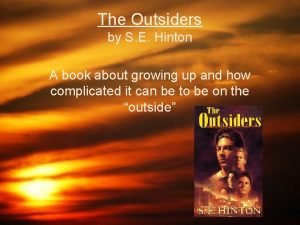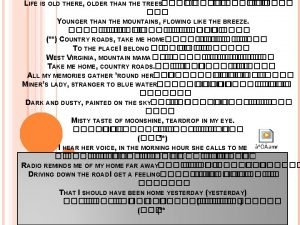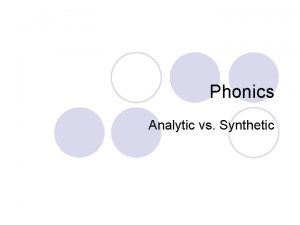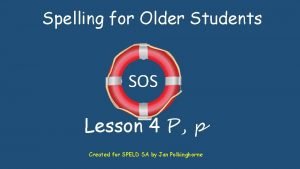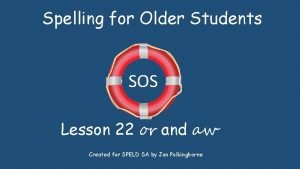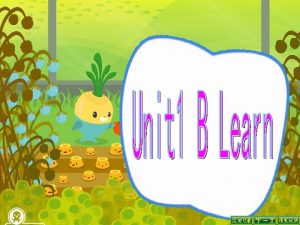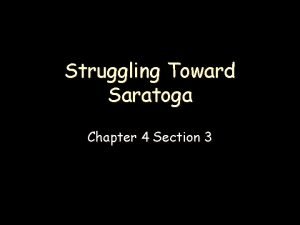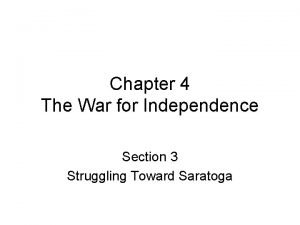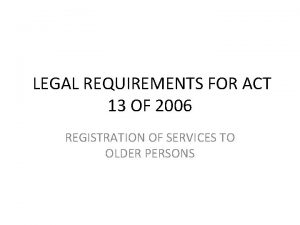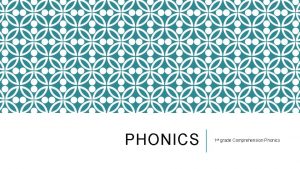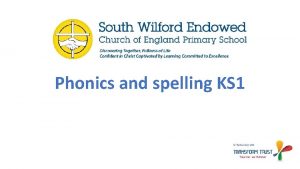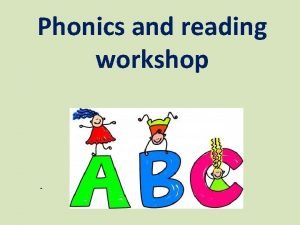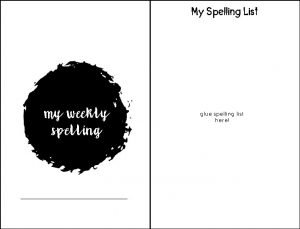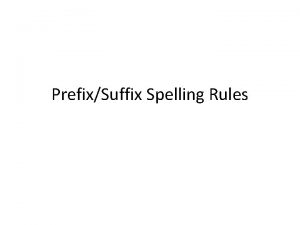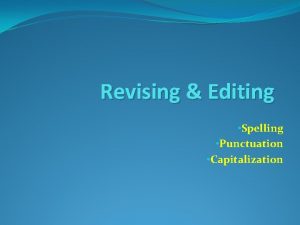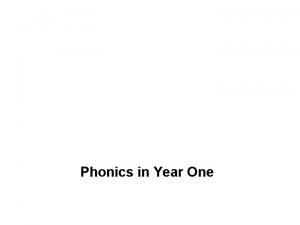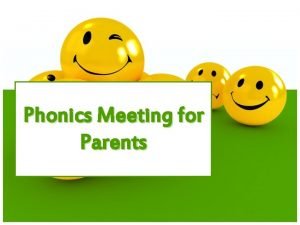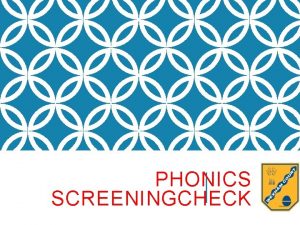Phonics and Spelling Interventions for Older Struggling Readers












- Slides: 12

Phonics and Spelling Interventions for Older Struggling Readers Patricia Cunningham Chapter 14

Making Words in Upper Grades • Like in younger grades, Making Words is a Guided Discovery lesson but with morphemic patterns: prefixes, suffixes, and roots that cue you to the pronunciation, spelling, and meaning • Contains 3 parts to the lesson: • Part one: Making Words – start with simple, basic words and build to larger words by changing letters, adding letters and creating new words with specific letters • Part Two: Sort Words into Patterns • Part Three: Transfer – Most important step in that teacher helps students use knowledge of words created and discovered to create new/more words not in the lesson, but related to the skill set

Brand Name Phonics This activity is based on the Using Words You Know format (see Cunningham, Ch. 10). Students learn how products, places, and signs in their environment can be the keys to unlocking the pronunciation and spelling of thousands of words. Begin the lesson revealing the actual box, can, ad, sign, etc. to the class. You may want to use a combo of real containers, advertisements, photos, etc. on a theme board in the classroom so students have these words constantly available for use. 1. For the first lesson, use three products whose names rhyme: Snack Pack, Slim Jim, Shake ‘N Bake. Display the products and let students talk about them. Do they recognize them? Do they eat them? Like them?

Brand Name Phonics 2. Students identify the names and write these names to head three columns on the board or chart. Help students notice that they rhyme and then underline the spelling pattern: -ack, -im, -ake. Point out that the spelling pattern begins with the first vowel and goes to the end of the syllable. 3. Have students divide a piece of paper into 3 columns and head these with the product names, underlining the spelling pattern in each. 4. Tell students you are going to display some words and they should write them under the product with the same spelling pattern. Show them words that you have written on index cards. Let various students go to the board and write the words as everyone is writing them on their paper. Words to use: dim back cake Kim rack trim track take Tim snake Have students verbalize the strategy they used to read the words.

Brand Name Phonics 5. Explain to students that thinking of rhyming words can help them spell also. This time do not show them the words, but say the words and students will have to decide which product they rhyme with and the spelling pattern to spell them. Have them write the words under the product word that will help aid in spelling. Have a student write each word on the chart or board. Some words you might pronounce: black swim lake flake smack skim shack quake brim Have students verbalize the strategy and lead them to explain: If slim is spelled s-l-i-m, brim is probably spelled b-r-i-m. 6. End this part by helping students verbalize that in English, words that rhyme often have the same spelling pattern and that good readers and spellers don’t sound out every letter; rather, they try to think of a rhyming word and read or spell the word using the pattern in the rhyming word.

Brand Name Phonics 7. Explain that using the rhyme to help them read and spell words works with longer words too. Show students these words written on index cards and have them write them under the appropriate product. Once the word is written on the board or chart, have them pronounce the word, making the last syllable rhyme with the product: victim shortcake paperback horseback retake flashback denim soundtrack drawback feedback 8. Say these words and have students decide which product the last syllable rhymes with and use that spelling pattern to spell it. Give help with the spelling of the first part if needed: handshake outback blackjack remake Muslim unpack bookrack snowflake hijack racetrack 9. Again, end the lesson by helping students notice how helpful it is to think of a rhyming word they know how to spell when trying to read or spell an unknown word. * It is best to spend only 15 -20 minutes during any one session with a lesson.

The Wheel The popular game show Wheel of Fortune is premised on the idea that meaning and some letters allow you to figure out many words. In this game, meaning is provided by the category in which the word belongs. A variation of this game can be used to introduce polysyllabic words and teach students to use meaning and all the letters they know. Here’s how to play The Wheel. 1. Remind students that many words can be figured out, even when they can’t decode all the chunks, if they think about what makes sense and whether it has the parts they do know in the right places. Survey students to see who is familiar with the game show Wheel of Fortune. Explain, step by step, how your version will be different:

The Wheel • Contestants guess all letters without considering if they are consonants or vowels. • They must have all letters filled in before they can say the word. (This is to encourage them to learn to spell. ) • They will win paper clips, bingo chips, etc. instead of great prizes. • Vanna will not be there to turn the letters! 2. 3. 4. Write the category for the game on the board and draw blanks for each letter in the first word. Have a student begin by asking, “Is there a letter …. ? ” If the student guesses a correct letter, fill that letter in. Give that student one paper clip for each time that letter occurs. Let the students continue to guess letters until s/he gets a “No. ” When a student asks for a letter that is not there, write the letter above the puzzle and go on to the next student. Make sure all letters are filled in before anyone is allowed to guess. (This shows the importance of spelling and attending to common spelling patterns. ) Give the person guessing the word 5 bonus paper clips.

Mystery Word Match This game was developed by P. Cunningham to help children learn to look for familiar chunks in unfamiliar big words. 1. To begin the game the teacher has a polysyllabic word in mind. This word is the “mystery word. ” Teacher draws the number of short blanks to indicate the number of letters in the mystery word. Then s/he writes three clue words of the mystery word under the letter blanks. ____ testimony celebrate direction

Mystery Word Match 2. Each clue word should have a chunk of the mystery word in the same position in the word and with the same pronunciation. Sometimes the chunks are syllables, sometimes they are larger than syllables. It is important that students not only focus on the syllables because when they are decoding a big word, they access from their word store the words with the largest chunks. Sometimes the chunks are roots, prefixes, and suffixes, but sometimes they are just familiar parts. (Ex. : entertainment – Students might recognize 3 chunks: enter, -tain, -ment) 3. As each clue word is written, the teacher and students pronounce it and put it in a meaningful sentence. Before guessing which part of which clue word is in the mystery word, the students should pronounce the words again to assure that everyone can easily pronounce the clue words.

Mystery Word Match 4. A student is chosen and begins by asking if the mystery word “begins like, ” “has a middle like, ” or “ends like” one of the clues. If the answer is “yes” the teacher writes the letters on the correct lines and the student continues to ask. If the answer is “no” the turn goes to the next student. 5. Mystery Word Match is a simple game and students of all ages love playing it. A few cautions, however. The child who finishes putting the word in the letter blanks must also pronounce the word. If s/he cannot, play passes to the next person. If you enforce this rule and if you and your students have pronounced the clue words several times before beginning, even struggling readers will pay attention to the pronunciation of the parts of the clue words. Also, the game is more meaningful if you use big words that are part of your curriculum.

Mystery Word Match Sample script for this game. Carl: Does the mystery word begin like direction? Teacher: No, I am sorry. It’s Terry’s turn. Terry: Does the mystery word end like direction? Teacher: No, I am sorry. It is Jared’s turn. Jared: Does the mystery word have a middle like direction? Teacher: Yes it does! Teacher writes re on the appropriate letter lines: _ _ r e _ _ Jared: Does the mystery word begin like celebrate? Teacher: Yes, it does. Teacher writes ce on the appropriate lines: cere____ Teacher: Jared, you may ask another question. Jared: Does the mystery word end like testimony? Teacher writes mony: c e r e m o n y. Jared pronounces the word ceremony and wins this round of Mystery Word Match.
 The outsiders adapted for struggling readers
The outsiders adapted for struggling readers Life is older older than the trees
Life is older older than the trees Critical reading meaning
Critical reading meaning Synthetic vs analytic phonics
Synthetic vs analytic phonics Sos spelling for older students
Sos spelling for older students Sos spelling for older students
Sos spelling for older students Shorter taller older tall
Shorter taller older tall Chapter 4 section 3 struggling toward saratoga
Chapter 4 section 3 struggling toward saratoga Struggling in silence
Struggling in silence Remediation of the struggling medical learner
Remediation of the struggling medical learner Chapter 4 section 3 struggling toward saratoga
Chapter 4 section 3 struggling toward saratoga Mental health and older adults
Mental health and older adults Older persons act norms and standards
Older persons act norms and standards
